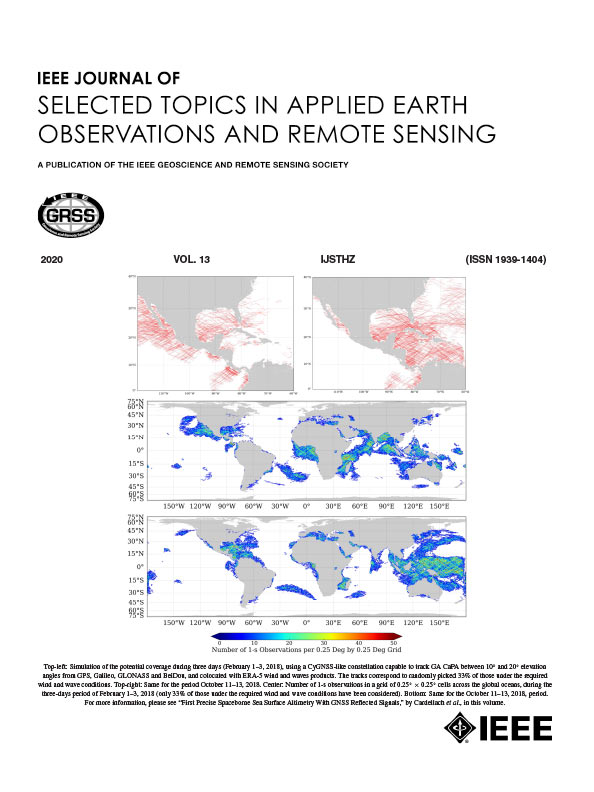考虑空间相关性和异质性的多源遥感数据提高GEDI地上生物量密度产品的空间连续性
IF 5.3
2区 地球科学
Q1 ENGINEERING, ELECTRICAL & ELECTRONIC
IEEE Journal of Selected Topics in Applied Earth Observations and Remote Sensing
Pub Date : 2025-09-18
DOI:10.1109/JSTARS.2025.3611427
引用次数: 0
摘要
准确、长期估算森林地上生物量密度(AGBD)对于监测陆地生态系统动态和定量评估森林在全球碳循环中的能力及其对减缓气候变化的贡献至关重要。同时,样地AGBD测量精度高,但缺乏时空连续性。全球生态系统动力学调查(GEDI)提供了全球水平AGBD的空间间断估计。为了克服这些挑战,我们提出了一个将GEDI网格数据与多源遥感数据相结合的AGBD空间相关性和异质性模型。为了进一步缓解gedi导出的AGBD分布的空间不连续性,提出了结合空间特征向量(EV)和空间相互作用项(SIT)的LightGBM模型(LGB_EV_SIT)。以gedi导出的AGBD为参考,基于多源遥感变量对关键预测指标进行了识别和排序。构造空间权重矩阵来反映GEDI AGBD网格的空间分布。基于空间权重矩阵提取空间ev和sit。与不考虑相关性和相互作用的LGB模型(r = 0.61 ~ 0.82, MRE = 38.6% ~ 54.3%, RMSE = 45.91 ~ 54.60 Mg/ha)相比,LGB_EV_SIT模型表现出更好的性能(r = 0.85 ~ 0.87, MRE = 31.5% ~ 39.1%, RMSE = 36.47 ~ 46.17 Mg/ha)。此外,该框架被应用于2019年至2022年美国西部的森林AGBD地图,从而能够检测森林随时间的变化。所提出的模型提供了新的可能性,可以准确地生成长时间序列的森林生物量和碳储量的完整地图。本文章由计算机程序翻译,如有差异,请以英文原文为准。
Improving the Spatial Continuity of GEDI Aboveground Biomass Density Products Using Multisource Remote Sensing Data With Consideration of Spatial Correlation and Heterogeneity
Accurate, long-term estimation of forest aboveground biomass density (AGBD) is essential for monitoring terrestrial ecosystem dynamics and quantitatively assessing the capacity of forests in the global carbon cycle and their contribution to mitigating climate change. Meanwhile, plot-level AGBD measurements are highly accurate but lack spatial and temporal continuity. Global ecosystem dynamics investigation (GEDI) provides spatially discontinued estimates of global-level AGBD. To overcome these challenges, we proposed a model incorporating spatial correlation and heterogeneity for AGBD estimation, which combines GEDI gridded data with multisource remote sensing data. To further mitigate the spatial discontinuities in GEDI-derived AGBD distribution, a LightGBM model (LGB_EV_SIT) incorporating spatial eigenvectors (EV) and spatial interaction terms (SIT) was proposed. Using GEDI-derived AGBD as a reference, key predicted indicators were identified and ranked based on multisource remote sensing variables. A spatial weight matrix was constructed to reflect the spatial distribution of the GEDI AGBD grids. Spatial EVs and SITs were extracted based on the spatial weight matrix. Compared with the LightGBM model (LGB) without considering the correlation and interaction (r = 0.61–0.82, MRE = 38.6% –54.3%, RMSE = 45.91–54.60 Mg/ha), LGB_EV_SIT exhibits better performance (r = 0.85–0.87, MRE = 31.5% –39.1%, RMSE = 36.47–46.17 Mg/ha). Furthermore, the framework was applied to map forest AGBD across the western USA from 2019 to 2022, enabling the detection of forest changes over time. The proposed model provides new possibilities to accurately generate wall-to-wall maps of forest biomass and carbon stocks over a long time series.
求助全文
通过发布文献求助,成功后即可免费获取论文全文。
去求助
来源期刊
CiteScore
9.30
自引率
10.90%
发文量
563
审稿时长
4.7 months
期刊介绍:
The IEEE Journal of Selected Topics in Applied Earth Observations and Remote Sensing addresses the growing field of applications in Earth observations and remote sensing, and also provides a venue for the rapidly expanding special issues that are being sponsored by the IEEE Geosciences and Remote Sensing Society. The journal draws upon the experience of the highly successful “IEEE Transactions on Geoscience and Remote Sensing” and provide a complementary medium for the wide range of topics in applied earth observations. The ‘Applications’ areas encompasses the societal benefit areas of the Global Earth Observations Systems of Systems (GEOSS) program. Through deliberations over two years, ministers from 50 countries agreed to identify nine areas where Earth observation could positively impact the quality of life and health of their respective countries. Some of these are areas not traditionally addressed in the IEEE context. These include biodiversity, health and climate. Yet it is the skill sets of IEEE members, in areas such as observations, communications, computers, signal processing, standards and ocean engineering, that form the technical underpinnings of GEOSS. Thus, the Journal attracts a broad range of interests that serves both present members in new ways and expands the IEEE visibility into new areas.

 求助内容:
求助内容: 应助结果提醒方式:
应助结果提醒方式:


